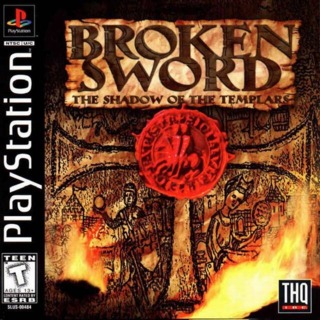Adventure Gaming Defined
You play as an American in Paris named George Stobbart, enjoying your vacation outside of a French cafe. While relaxing and enjoying the scenery, an odd man dressed as a clown enters the cafe and scuffles off in a hurry. The cafe explodes, and the mystery begins. George eventually learns that the incident is linked to a modern version of an ancient organization called the Knights Templar, and a plan to take over the world. George will travel several European countries and locations in the Middle East, having discussions with some very cleverly scripted and drawn characters, with some clues in their comical banter. He'll solve some puzzles, which are by no means simple, but aren't so taxing as to put off the grey-matter-imparied. Among the characters, George will meet a cute French reporter who becomes George's love-interest throughout the "Broken Sword" series. The story is unique and engaging, but Revolution Software didn't stop there, providing a game that is really enhanced by the very-well-drawn classical cartoonish backgrounds, well-done animation for character movement, and an incredibly charming musical score. These are some of the best drawn backgrounds I've experienced in a game. The fact that they were prerendered only seems to add to their visual clarity, and allow them to provide a mythical yet believable foray into the many environments the player will discover. The musical score is no slouch either. This is some of the best mood music in any game. The score really transports the player into a relaxing European mindset, tensing up only at moments which call for it. The music very much reminds me stylistically of some of the softer compositions from the British Light Music school, sounding in tone and mood similar to compositions like "The Haunted Ballroom" by Geoffrey Toye, or "Cradle Song" by Gordon Jacob. The voice-work and dialog are some of the best in any game, and keep it very much centered on its story-driven plot, adding to the overall believability of the story. You are likely to both laugh and marvel at the comical characters you will run into along the adventure.
Two-dimensional adventure games often-times use point-and-click interfaces of various varieties, and this game is no exception. However, the design of this particular interface is where this game really shines. Most adventure game systems around this time have either very limited options, or complex control schemes, both in activity and dialogue. The developers of this game created an interface in which new clues and information are kept in one inventory, while items discovered are kept in another inventory. When entering into dialog with another character in the game, both of these inventories appear. This gives the game a real sense of non-linear discovery, though perhaps artificial. You must find certain clues, items, or information, before such dialogue options will open with each character. That the game tracks these discoveries makes the appearance of new options at other points in the game a step above some of the non-sequitur changes experienced in other adventure games. Backtracking becomes part of the game, but unlike other adventure games, it doesn't really feel like backtracking, because the sense of discovery along with the dramatically unfolding storyline, keep the game from feeling contrived or stagnant, and unlike some adventure games, it is possible to die based on unwise decisions made during the game.
Execution of gameplay in this PC release is a breeze. Loading times are low, and the point-and-click control schemes are clearly made for the PC's interfaces. There are a lot of points in the game where speed and accuracy are required to succeed (and in some cases, not die some horrid death). None of these situations were impossible, or held back by the control scheme. I couldn't find a single bug in the entire game, and that's saying something that can't be said for the Playstation and Gameboy Advance ports of the game. I simply have no choice but to rate this PC-release of the game as high as possible. Its that well-designed.
Revolution Software literally introduced a renaissance in the adventure genre with the release of this game. Its perhaps the best-known game in that genre, and few games since have so fully reinvented adventure gaming as we know it. This game is my favorite in that genre, in any of its various platform releases, and I am not the only one who recognizes it as such. That is perhaps the best testament to this game's ongoing popularity, in that its fans have never forgotten the lesson of what is possible, and keep waiting for other developers to raise the bar. Of course, that may never happen again, but at least we still have the "Broken Sword" series.

